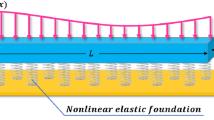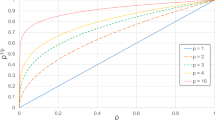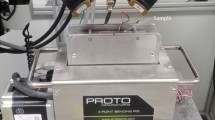Abstract
An experimental method was developed to determine the through thickness elastic modulus profile of a multi-layered functionally graded material. The method consists of two sets of mechanical experiments, a tensile test and a four-point bend test, from which the strains at two locations on either surfaces of the beam are measured for known applied loads. A one-dimensional version of classical laminate theory is then used to calculate the beam stiffness coefficients from the experimentally obtained data. Finally, an inverse analysis is performed in which a minimization scheme using Genetic Algorithm is utilized to determine the elastic modulus of each layer. The applicability of such method is demonstrated for a seven-layered ceramic/metal functionally graded structure with layers ranging from pure Ti to 85 % TiB-15 % Ti on the ceramic-rich side. The elastic modulus of each layer within the examined material is back calculated based on the proposed inverse analysis. The results indicate that the proposed method can be used to obtain the through thickness elastic modulus profile of discretely graded materials with reasonable accuracy.













Similar content being viewed by others
References
Mortensen A, Suresh S (1995) Functionally graded metals and metal-ceramic composites: part 1 processing. Int Mater Rev 40:239–265
Suresh S, Mortensen A (1997) Functionally graded metals and metal-ceramic composites: part 2 thermomechanical behavior. Int Mater Rev 42:85–116
Jin ZH, Batra RC (1996) Some basic fracture mechanics concepts in functionally graded materials. J Mech Phys Solids 44:1221–1235
Parameswaran V, Shukla A (1999) Crack-tip fields for dynamic fracture in functionally gradient materials. Mech Mater 31:579–596
Chalivendra VB (2008) Mode-I crack-tip stress fields for inhomogeneous orthotropic medium. Mech Mater 40:293–301
Abotula S, Kidane A, Chalivendra B, Shukla A (2012) Dynamic curving cracks in functionally graded materials under thermo-mechanical loading. Int J Solids Struct 49:1637–1655
Nazari A (2011) Modeling fracture toughness of ferritic and austenitic functionally graded steel based on strain gradient plasticity theory. Comput Mater Sci 50:3238–3244
Kommana R, Parameswaran V (2009) Experimental and numerical investigation of a cracked transversely graded plate subjected to in plane bending. Int J Solids Struct 46:2420–2428
Wadgaonkar SC, Parameswaran V (2009) Structure of near-tip stress field and variation of stress intensity factor for a crack in a transversely graded material. J Appl Mech 76:1–9
Kidane A, Shukla A (2010) Quasi-static and dynamic fracture initiation toughness of Ti/TiB layered functionally graded material under thermo-mechanical loading. Eng Fract Mech 77:479–491
Koohbor B, Mallon S, Kidane A (2014) Through thickness fracture behavior of transversely graded Ti/TiB material. In: Carroll J, Daly S (eds) Fracture, fatigue, failure and damage evolution - proceedings of the annual conference on experimental and applied mechanics. Springer, US, pp 51–56
Koohbor B, Kidane A, Mallon S (2014) Effect of elastic properties of material composition on the fracture response of transversely graded ceramic/metal material. Mater Sci Eng A 619:281–289
Weissenbek E, Pettermann HE, Suresh S (1997) Elasto-plastic deformation of compositionally graded metal-ceramic composites. Acta Mater 45:3401–3417
Yu J, Kidane A (2014) Modeling functionally graded materials containing multiple heterogeneities. Acta Mech 225:1931–1943
Gasik MM (1998) Micromechanical modeling of functionally graded materials. Comput Mater Sci 13:42–55
Rahman S, Chakraborty A (2007) A stochastic micromechanical model for elastic properties of functionally graded materials. Mech Mater 39:548–563
Dao M, Gu P, Maewal A, Asaro AJ (1997) A micromechanical study of residual stresses in functionally graded materials. Acta Mater 45:3265–3276
Nakamura T, Wang T, Sampath S (2000) Determination of properties of graded materials by inverse analysis and instrumented indentation. Acta Mater 48:4293–4306
Suresh S (2001) Graded materials for resistance to contact deformation and damage. Science 292:2447–2451
Branch NA, Arakere NK, Subhash G, Klecka MA (2011) Determination of constitutive response of plastically graded materials. Int J Plast 27:728–738
Butcher RJ, Rousseau CE, Tippur HV (1999) A functionally graded particulate composite: preparation, measurements and failure analysis. Acta Mater 47:259–268
Marur PR, Tippur HV (1998) Evaluation of mechanical properties of functionally graded materials. J Test Eval 26:539–545
Liu GR, Han X, Lam KY (2011) Material characterization of FGM plates using elastic waves and an inverse procedure. J Compos Mater 35:954–971
Liu GR, Han X, Xu YG, Lam KY (2001) Material characterization of functionally graded material by means of elastic waves and a progressive-learning neural network. Compos Sci Technol 61:1401–1411
Liu GR, Han X, Lam KY (2002) A combined genetic algorithm and nonlinear least squares method for material characterization using elastic waves. Comput Methods Appl Mech Eng 191:1909–1921
Han X, Liu GR (2003) Computational inverse technique for material characterization of functionally graded materials. AIAA J 41:288–295
Yu J, Wu B (2009) The inverse of material properties of functionally graded pipes using the dispersion of guided waves and an artificial neural network. NDT&E Int 42:452–458
Avril S, Bonnet M, Bretelle AS, Grediac M, Hild F, Ienny P, Latourte F, Lemosse D, Pagano S, Pagnacco E, Pierron F (2008) Overview of identification methods of mechanical parameters based on full-field measurements. Exp Mech 48:381–402
Xavier J, Avril S, Pierron F, Morais J (2009) Variation of transverse and shear stiffness properties of wood in a tree. Compos Part A 40:1953–1960
Jones RM (1999) Mechanics of composite materials, 2nd edn. Taylor and Francis, US
Kidane A, Shukla A (2008) Dynamic constitutive behavior of Ti/TiB FGM under thermo-mechanical loading. J Mater Sci 43:2771–2777
Hill MR, Carpenter RP, Paulino GH, Munir Z, Gibeling JC (2002) Fracture testing of a layered functionally graded materials. In: Salem JA, Quinn GD, Jenkins MG (eds) Fracture resistance testing of monolithic and composite brittle materials. American Society for Testing and Materials, PA, pp 169–184
Gouppe AJ, Vel SS (2006) Two-dimensional optimization of material composition of functionally graded materials using meshless analyses and a genetic algorithm. Comput Methods Appl Mech Eng 195:5926–5948
Sun K, Hong K, Yuan L, Shen Z, Ni X (2014) Inversion of functional graded materials elastic properties from ultrasonic lamb wave phase velocity data using genetic algorithm. J Nondestruct Eval 33:34–42
Han X, Liu GR (2003) Computational inverse technique for material characterization of functionally graded materials. AIAA J 41:288–295
Anand A (2010) Elastic profile determination of functionally graded material. Dissertation, Indian Institute of Technology Kanpur
Panda KB, Ravi Chandran KS (2003) Titanium-titanium boride (Ti-TiB) functionally graded materials through reaction sintering: synthesis, microstructure and properties. Metall Mater Trans A 34:1993–2003
Morsi K, Patel VV (2007) Processing and properties of titanium-titanium boride (TiBw) matrix composites—a review. J Mater Sci 42:2037–2047
Ma ZY, Tjong SC, Gen L (2000) In-situ Ti-TiB metal-matrix composite prepared by a reactive pressing process. Scr Mater 42:367–373
Acknowledgments
The financial support of NSF under Grant No EEC-1342379 is gratefully acknowledged. Professor Michael A. Sutton is gratefully acknowledged for the valuable discussions and his useful suggestions.
Author information
Authors and Affiliations
Corresponding author
Rights and permissions
About this article
Cite this article
Koohbor, B., Mallon, S., Kidane, A. et al. Through Thickness Elastic Profile Determination of Functionally Graded Materials. Exp Mech 55, 1427–1440 (2015). https://doi.org/10.1007/s11340-015-0043-z
Received:
Accepted:
Published:
Issue Date:
DOI: https://doi.org/10.1007/s11340-015-0043-z




